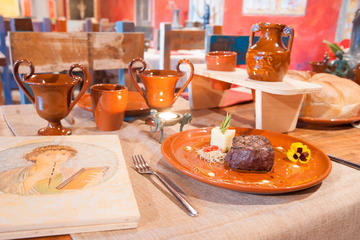
Kundle, Austria
by Josephine Montgomery
Fate, if you are willing to follow, can lead to some fascinating and extraordinary journeys. Never one to follow the beaten path I took the road less traveled and emailed embassies for wood-carving schools across the globe. A reply from the Austrian embassy intrigued me, it told of Kundle, a picturesque town in Austria and a Master Carver. Kundle also had a train station. Many small towns in Austria do not have transportation services beyond local buses; the quaint little train station in Kundle was our magic carpet.
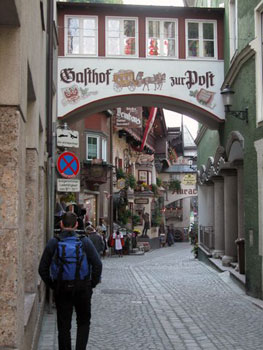 Joe, my husband, and I arrived in Munich, Germany on a sunny afternoon in September. Using the airport mini bus service we arrived in Kundle an hour and a half later. Anna, the Master Carver’s wife, a small, slim lady with sparkling eyes ran down a flight of stairs to greet us. She whisked us to a spacious second floor guest room with a large deck overlooking gardens and a spectacular view of the mountains. We followed Anna as she ran across the garden and up another flight of stairs that led to a door with an impressive eagle carved in relief. Stepping through the door was akin to entering a tree house filled with industrious wood spirits. Sunlight filtered through floor to ceiling windows of a huge workshop, sharp tools sizzled across fragrant pine. Intricate carvings came to life under Herr Binder’s soft spoken direction and shrewd eye.
Joe, my husband, and I arrived in Munich, Germany on a sunny afternoon in September. Using the airport mini bus service we arrived in Kundle an hour and a half later. Anna, the Master Carver’s wife, a small, slim lady with sparkling eyes ran down a flight of stairs to greet us. She whisked us to a spacious second floor guest room with a large deck overlooking gardens and a spectacular view of the mountains. We followed Anna as she ran across the garden and up another flight of stairs that led to a door with an impressive eagle carved in relief. Stepping through the door was akin to entering a tree house filled with industrious wood spirits. Sunlight filtered through floor to ceiling windows of a huge workshop, sharp tools sizzled across fragrant pine. Intricate carvings came to life under Herr Binder’s soft spoken direction and shrewd eye.
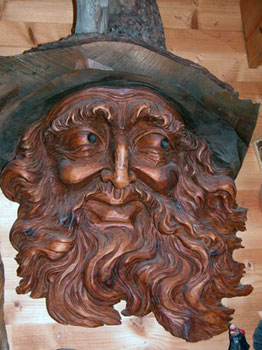 Carving in Kundle was a unique experience, surrounded by beautiful carvings it was impossible not to be inspired. Eagles, wings outstretched, perched near windows as though waiting to take flight. Alpine Ibex, with enormous backward curving horns, seemed ready to leap off craggy, wooden rocks. Larger than life faces with swirling beards, tangled hair and mischievous eyes smiled down from walls as we carved.
Carving in Kundle was a unique experience, surrounded by beautiful carvings it was impossible not to be inspired. Eagles, wings outstretched, perched near windows as though waiting to take flight. Alpine Ibex, with enormous backward curving horns, seemed ready to leap off craggy, wooden rocks. Larger than life faces with swirling beards, tangled hair and mischievous eyes smiled down from walls as we carved.
Herr Binder, a tall distinguished man with a mop of silver hair, greeted his students each morning with his wife Anna, and daughter Christa in the spacious dining room. The family spoke good English as did other students from northern and southern Germany. I thought Anna, with her boundless energy and sharp wit, to be in her mid sixties and daughter Christa her mid forties. After breakfast one morning I asked who had won the large silver trophy on the mantelpiece. The room fell silent when Anna explained it was hers. She once raced cars for a hobby and won the trophy when she was seventy eight years old. A swift calculation from the date on the trophy made Frau Anna Binder ninety one years old.
“Were you not afraid for your wife?” asked one of the students.
“Not at all,” replied Herr Binder, “but I was afraid for the car.”
“Mother skied until she was eighty five years old, she used to buy very modern ski outfits,” said Christa with a sniff, “she thought they made her look younger on the slopes.”
“I only stopped skiing after you broke your leg on the mountain and you wouldn’t drive me to the slopes,” Anna replied with a sharp sideways glance at her daughter.
With old world courtesy Herr Binder excused himself, he had a small errand to run before class. The students watched as he roared out of the garage on a streamlined silver and black electric vehicle, similar to a sporty motorcycle with four wheels. He gave a cheery wave as he drove past dressed in black leather jacket and cap set at a jaunty angle.
“In Austria,” Anna said, “you cannot drive a car after your ninetieth birthday.”
Christa said a couple of weeks previously her father purchased a pine tree and she helped him stack the pre-cut wood to dry ready for when he needed it in a year or two. Herr Binder at ninety years of age was an optimist.
 Postcards often depict glimpses of destinations quite unrelated to reality. Kundle is the exception. Intricately carved wooden balconies and eves changed pastel colored walls of houses, shops and restaurants into whimsical gingerbread creations. Geraniums, petunias and ferns tumbled in cascades of color from every balcony and window box. The Hanging Gardens of Babylon could not have looked more beautiful. Narrow winding streets led to fountains where children splashed on their way home from school and towns people gathered to eat lunch. Five restaurants served a variety of food, we enjoyed authentic Austrian dishes in a restaurant where massive wood furnishings, beams and doors were heavily decorated with carvings. Family members gathered in large groups for dinner and men in colorful lederhosen stopped for a pint of lager en-route to festival rehearsals. As the atmosphere filled with camaraderie, clinking glasses, bursts of regional songs and laughter, enhanced by wafts from the kitchen of frying Wiener Schnitzel, Goulash and apfelstrudel, we felt we were on stage, part of the cast in a movie extravaganza.
Postcards often depict glimpses of destinations quite unrelated to reality. Kundle is the exception. Intricately carved wooden balconies and eves changed pastel colored walls of houses, shops and restaurants into whimsical gingerbread creations. Geraniums, petunias and ferns tumbled in cascades of color from every balcony and window box. The Hanging Gardens of Babylon could not have looked more beautiful. Narrow winding streets led to fountains where children splashed on their way home from school and towns people gathered to eat lunch. Five restaurants served a variety of food, we enjoyed authentic Austrian dishes in a restaurant where massive wood furnishings, beams and doors were heavily decorated with carvings. Family members gathered in large groups for dinner and men in colorful lederhosen stopped for a pint of lager en-route to festival rehearsals. As the atmosphere filled with camaraderie, clinking glasses, bursts of regional songs and laughter, enhanced by wafts from the kitchen of frying Wiener Schnitzel, Goulash and apfelstrudel, we felt we were on stage, part of the cast in a movie extravaganza.
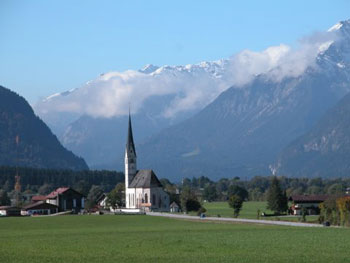 Strolling home one evening after a delicious meal of smoked trout in a mid seventeenth century Pension we heard the clanging of cow bells. A herd of cows came bustling up a side-street heading for their night quarters in a barn attached to a house. At seven o’clock in the evening it was the duty of anyone passing by to stand at the top of the street and encourage the animals not to make a detour through town.
Strolling home one evening after a delicious meal of smoked trout in a mid seventeenth century Pension we heard the clanging of cow bells. A herd of cows came bustling up a side-street heading for their night quarters in a barn attached to a house. At seven o’clock in the evening it was the duty of anyone passing by to stand at the top of the street and encourage the animals not to make a detour through town.
Most days for lunch we bought fresh picked fruit, local cheese and crackers, walked over Kundle river bridge and ate our mid-day meal sitting in a tiny park by a big goldfish pond in the shadow of a tall pink and white church. Strolling past the grocery stores after lunch we marveled at the number of elderly ladies loading groceries into large baskets on the front and rear of their bicycles and threading more shopping bags along the handlebars. The shopping expeditions became even more hazardous one afternoon when a brief rain shower brought them to a halt. Undaunted the ladies clicked an umbrella over their head, climbed back on their bicycle and pedaled off, steering one handed, towards home.
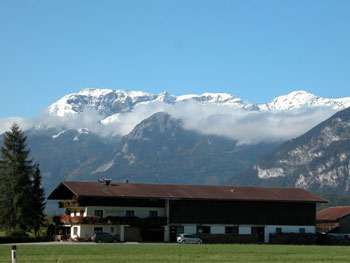 I signed up for three weeks carving instruction, choosing to carve mornings only, leaving time to catch the train to numerous small Tyrolean towns within thirty minutes ride of Kundle. Even the smallest town boasted a castle, large or small, huddled on mountain tops the castles looked down on the inhabitants like benevolent protectors. Rattenburg with a population of 440 is the smallest town in the country. Founded in the 14th century it was built in the shadow of Rat Mountain to protect it from marauders. Following ancient cobblestone streets we stumbled upon a glass blowing demonstration. A cavernous area hewn deep into rock displayed hand blown glass animals, birds, dragons and flowers. Suspended from the cave ceiling lit by soft, revolving colored lights the glass sculptures cast dancing shadows across ancient stone walls. Sparkling Austrian crystal, dazzling rainbows of color, glistened like stalactites in dark corners. This little town, characterized by its medieval ambience is known far and wide as “glass town.”
I signed up for three weeks carving instruction, choosing to carve mornings only, leaving time to catch the train to numerous small Tyrolean towns within thirty minutes ride of Kundle. Even the smallest town boasted a castle, large or small, huddled on mountain tops the castles looked down on the inhabitants like benevolent protectors. Rattenburg with a population of 440 is the smallest town in the country. Founded in the 14th century it was built in the shadow of Rat Mountain to protect it from marauders. Following ancient cobblestone streets we stumbled upon a glass blowing demonstration. A cavernous area hewn deep into rock displayed hand blown glass animals, birds, dragons and flowers. Suspended from the cave ceiling lit by soft, revolving colored lights the glass sculptures cast dancing shadows across ancient stone walls. Sparkling Austrian crystal, dazzling rainbows of color, glistened like stalactites in dark corners. This little town, characterized by its medieval ambience is known far and wide as “glass town.”
About a two hour train ride from Kundle is Salzburg, an impressive baroque city with a stunning river walk leading towards the impressive white fortress, Festung Hohensalzburg. Magnificent Salzburg, home of Mozart, is not to be missed, but the town of Kufstein stole my heart.
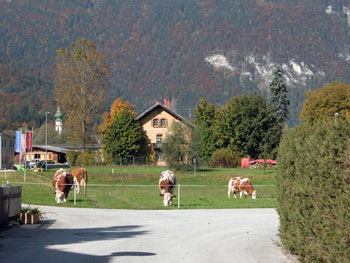 Kufstein, located between South Tyrol in Italy and Bavaria in Germany is known as the “pearl of the Tyrol.” It has about 15,000 inhabitants, the majestic Kufstein Fortress, a massive fortification dating from the mid 12th century rears above the town on a precipitous crag. An interesting feature of the fortress is the “Heroes” organ built in 1931 it was the first open air organ in the world. During summer months concerts are played at noon each day in memory of those who died in the two world wars. In both world wars the Fortress tunnels were used for shelter. Sitting in an out-door café by the beautiful Inn River savoring chocolate cream cake while listening to the soulful organ music float down from the fortress and drift through the flower filled historical district below is a magical experience. The music can be heard eight miles away.
Kufstein, located between South Tyrol in Italy and Bavaria in Germany is known as the “pearl of the Tyrol.” It has about 15,000 inhabitants, the majestic Kufstein Fortress, a massive fortification dating from the mid 12th century rears above the town on a precipitous crag. An interesting feature of the fortress is the “Heroes” organ built in 1931 it was the first open air organ in the world. During summer months concerts are played at noon each day in memory of those who died in the two world wars. In both world wars the Fortress tunnels were used for shelter. Sitting in an out-door café by the beautiful Inn River savoring chocolate cream cake while listening to the soulful organ music float down from the fortress and drift through the flower filled historical district below is a magical experience. The music can be heard eight miles away.
We left Kundle with requests to please come back again and hugs from the entire Binder family, climbing onboard the minibus they waved until we were out of sight. On the long flight home I pondered why the carving experience in Kundle had been so rewarding. There was no hurrying and scurrying from student to student. Herr Binder’s chisels moved effortlessly over wood as though sketching, he recognized who needed help and sat with a student until, under his soft spoken guidance, problems were resolved. The town of Kundle generated the same air of tranquility, no graffiti, no litter, streets were swept clean each day and everyone enjoyed each others company, sharing their generosity of spirit with strangers. It was a unique world, where elderly ladies rode bicycles to shop and a ninety year old Master wood-carver gave classes.
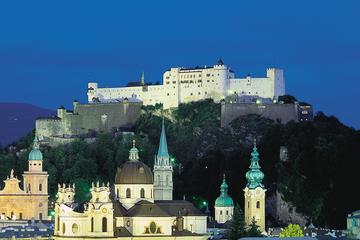
Dinner Experience at Salzburg Fortress and Mozart Concert in Salzburg
If You Go:
Slide views of Kufstein past and present day.
www.heimat-kufstein.at
Kufstein: Information on Fortress and Town.
www.planetware.com/kufstein/feste-kufstein-a-t-feskuf.htm
Rattenburg: Scroll down page to view 10 Photos
www.tirolaustria.co.uk/?Rattenberg_Tirol
Information on Rattenburg
www.tyrol.tl/en/tyrols-holiday-areas/kufstein-and-surroundings/rattenberg.html
Kundle: Information on 13th Century Kundle.
www.tyrol.tl/en/tyrols-holiday-areas/kufstein-and-surroundings/kundl.html
About the author:
Josephine Montgomery is a British subject and citizen of the world. She has traveled extensively in the Middle East, and for two years, while living in a small Arab village, studied written and spoken Arabic at Amman University in the Hashemite Kingdom of Jordan. She writes travel articles and children’s stories.
All photos are by Josephine Montgomery.

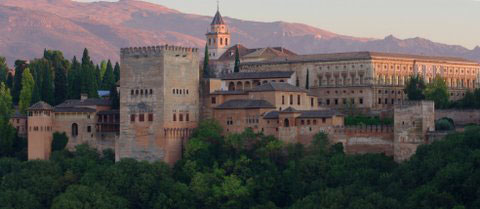

 The year was 1492 and as they rode into town Ferdinand and Isabella were accompanied by a certain Christopher Columbus, there to seek support for an expedition to the Indies.
The year was 1492 and as they rode into town Ferdinand and Isabella were accompanied by a certain Christopher Columbus, there to seek support for an expedition to the Indies. Perhaps the royal couple did not pick up on the allegorical design (the original meaning of harem, or al haram, is sanctuary). The four streams of paradise flow from each wing to the central fountain of aforementioned lions. The impression is that of a desert oasis, with the columns lining the courtyard standing in for palm trees.
Perhaps the royal couple did not pick up on the allegorical design (the original meaning of harem, or al haram, is sanctuary). The four streams of paradise flow from each wing to the central fountain of aforementioned lions. The impression is that of a desert oasis, with the columns lining the courtyard standing in for palm trees. The conquest of Granada was of such importance to Ferdinand and Isabella that they commissioned a royal chapel in the city to house their remains. Visitors can still pay their respects here, just around the corner from the muscular Christian cathedral.
The conquest of Granada was of such importance to Ferdinand and Isabella that they commissioned a royal chapel in the city to house their remains. Visitors can still pay their respects here, just around the corner from the muscular Christian cathedral. There was to be another brick-and-mortar response to Islam and at much closer quarters, within the walls of the Alhambra itself . When Charles V came to power in Spain, not long after the conquest of Granada, he wanted his residence to be both close to the Nasrid palaces and fit for an emperor.
There was to be another brick-and-mortar response to Islam and at much closer quarters, within the walls of the Alhambra itself . When Charles V came to power in Spain, not long after the conquest of Granada, he wanted his residence to be both close to the Nasrid palaces and fit for an emperor. It would appear that alongside the religious fervour that was to culminate in the expulsion of all Muslims from Spain in 1609, there was something of a grudging respect for their culture. On the day they entered Granada, Ferdinand and Isabella wore elaborate Moorish costumes which had been commissioned especially.
It would appear that alongside the religious fervour that was to culminate in the expulsion of all Muslims from Spain in 1609, there was something of a grudging respect for their culture. On the day they entered Granada, Ferdinand and Isabella wore elaborate Moorish costumes which had been commissioned especially. Walking up the Caldereria Nueva, a sloped street in the lower Albaicin and within sight of the Alhambra, you could be forgiven for thinking you’re not in Spain at all. That or you are, but it’s the middle ages. The narrow street is lined with souk style North African merchants and Moroccan teterias, or tea houses. The owners sit outside their shops at the quieter times and gossip here as they do in Fez, Cairo and Damascus. From the teterias the aroma of minted tea is accompanied by that of the sheesha, or water pipe. Arabic is the lingua franca in this neighborhood, along with French, Spanish and of course English.
Walking up the Caldereria Nueva, a sloped street in the lower Albaicin and within sight of the Alhambra, you could be forgiven for thinking you’re not in Spain at all. That or you are, but it’s the middle ages. The narrow street is lined with souk style North African merchants and Moroccan teterias, or tea houses. The owners sit outside their shops at the quieter times and gossip here as they do in Fez, Cairo and Damascus. From the teterias the aroma of minted tea is accompanied by that of the sheesha, or water pipe. Arabic is the lingua franca in this neighborhood, along with French, Spanish and of course English. Coincidence it seems, is to be found at the heart of this city’s defining moments as often as are these two faiths. Across the Darro valley, the Alhambra’s most prominent feature from here is the Comares tower which houses the Hall of the Ambassadors. It’s the most impressive and stately of the rooms a visitor will see on their tour, having just stepped in from the bright light of the Courtyard of the Myrtles, a delight for the ear as well as the eye, its fountains babbling at either end of a mirror smooth pool.
Coincidence it seems, is to be found at the heart of this city’s defining moments as often as are these two faiths. Across the Darro valley, the Alhambra’s most prominent feature from here is the Comares tower which houses the Hall of the Ambassadors. It’s the most impressive and stately of the rooms a visitor will see on their tour, having just stepped in from the bright light of the Courtyard of the Myrtles, a delight for the ear as well as the eye, its fountains babbling at either end of a mirror smooth pool. Some things change, and some never seem to. The centuries that have passed since Columbus’ voyage have frequently been troubled by encounters between Islam and Christianity, between both and secularism. The ramparts of the Alhambra have withstood. In our times of idealogical clash and religious hatred, the Moorish edifice stands all the more alluring; a testament to the shared history of cultures and faiths, if not reconciled then at least intertwined in the stone and tile work of the Alhambra and in the lives of its occupants.
Some things change, and some never seem to. The centuries that have passed since Columbus’ voyage have frequently been troubled by encounters between Islam and Christianity, between both and secularism. The ramparts of the Alhambra have withstood. In our times of idealogical clash and religious hatred, the Moorish edifice stands all the more alluring; a testament to the shared history of cultures and faiths, if not reconciled then at least intertwined in the stone and tile work of the Alhambra and in the lives of its occupants.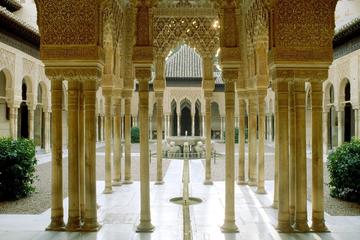
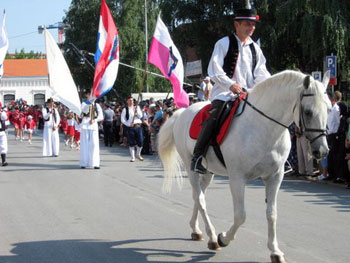
 Pope John XXIII praised the Ðakovo’s landmark as “the most beautiful church between Venice and Istanbul.” We were impressed by the cathedral’s neo-Gothic-Romanesque style even without the Pope’s words. Before we had time to fully appreciate the magnificent cathedral, we had to join in the first program of the day.
Pope John XXIII praised the Ðakovo’s landmark as “the most beautiful church between Venice and Istanbul.” We were impressed by the cathedral’s neo-Gothic-Romanesque style even without the Pope’s words. Before we had time to fully appreciate the magnificent cathedral, we had to join in the first program of the day. Religious practices have always been an integral part of all Croatian festivals. Ðakovacki Vezovi is no exception. Mass at the St. Peter’s Cathedral follows the parade.
Religious practices have always been an integral part of all Croatian festivals. Ðakovacki Vezovi is no exception. Mass at the St. Peter’s Cathedral follows the parade.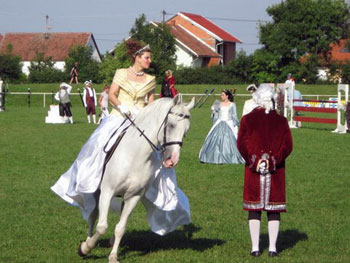 The highlight in the afternoon was equestrian competition and performance held in the hippodrome, showcasing the Lipizzaner breed. Ðakovo’s first official stud farm was founded more than 500 years ago, long before the Lipizzaner horses came to Ðakovo in 1806. But Ðakovo soon shifted exclusively to the breeding of these noble horses. The Lipizzaner breed has made Ðakovo famous beyond the Croatian borders for more than 200 years.
The highlight in the afternoon was equestrian competition and performance held in the hippodrome, showcasing the Lipizzaner breed. Ðakovo’s first official stud farm was founded more than 500 years ago, long before the Lipizzaner horses came to Ðakovo in 1806. But Ðakovo soon shifted exclusively to the breeding of these noble horses. The Lipizzaner breed has made Ðakovo famous beyond the Croatian borders for more than 200 years. Visitors could go to the stable for a close contact with these beautiful creatures. To my surprise, the horses remained calm even though so many strangers were moving around them. In the meantime, the equestrians were busy preparing the horses for the performances at the hippodrome.
Visitors could go to the stable for a close contact with these beautiful creatures. To my surprise, the horses remained calm even though so many strangers were moving around them. In the meantime, the equestrians were busy preparing the horses for the performances at the hippodrome.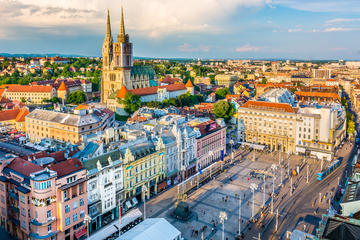
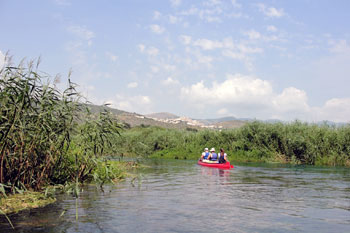
 I wonder what it would be like to live here in Abruzzo all the time, far from the pressures of city life, far from tourist traps, close to nature, and to inner peace. Like Celestine. Back in the thirteenth century, he lived higher up these rugged slopes, in a cave, until he was called to the Papacy. But he hated all the glitz and glamour, and missed his life as a hermit, so he swiftly issued a decree allowing popes to abdicate, and returned to his cave.
I wonder what it would be like to live here in Abruzzo all the time, far from the pressures of city life, far from tourist traps, close to nature, and to inner peace. Like Celestine. Back in the thirteenth century, he lived higher up these rugged slopes, in a cave, until he was called to the Papacy. But he hated all the glitz and glamour, and missed his life as a hermit, so he swiftly issued a decree allowing popes to abdicate, and returned to his cave. Yes, I think, turning back down the mountain, there’s a spiritual energy here. But I would want a little more material comfort than Celestine had: perhaps I could buy that stone ruin over there on the slope, and convert it. Like Ezio and Mariangela did. A few years ago, they decided to flee the pressures of city life, and bought an eighteenth century property here. They restored it using original materials, and made it into a four-bedroom B&B. They named it Casa Giumentina, after this valley. That’s where I’m staying…and I’m getting hungry. The sun is now warm on the back of my legs. As I approach the house, I see that breakfast has been laid out on the table under the oak tree. I can already smell the cappuccino…and Mariangela’s freshly baked apple cake.
Yes, I think, turning back down the mountain, there’s a spiritual energy here. But I would want a little more material comfort than Celestine had: perhaps I could buy that stone ruin over there on the slope, and convert it. Like Ezio and Mariangela did. A few years ago, they decided to flee the pressures of city life, and bought an eighteenth century property here. They restored it using original materials, and made it into a four-bedroom B&B. They named it Casa Giumentina, after this valley. That’s where I’m staying…and I’m getting hungry. The sun is now warm on the back of my legs. As I approach the house, I see that breakfast has been laid out on the table under the oak tree. I can already smell the cappuccino…and Mariangela’s freshly baked apple cake.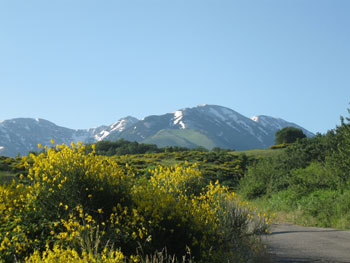 As I enter the village, I notice that the roads have been recently paved. There’s a feeling of progress, of development. After the war, this was one of the most depressed areas in Italy. People left in their hundreds, looking for work, often in mines in northern Europe. The population dropped from 2000 to 450. But things are changing: people are trickling back.
As I enter the village, I notice that the roads have been recently paved. There’s a feeling of progress, of development. After the war, this was one of the most depressed areas in Italy. People left in their hundreds, looking for work, often in mines in northern Europe. The population dropped from 2000 to 450. But things are changing: people are trickling back.
 ‘My husband died in the war,’ she says. ‘I never married again. I couldn’t have my sons calling another man “papà”.’
‘My husband died in the war,’ she says. ‘I never married again. I couldn’t have my sons calling another man “papà”.’ I stroll down to Il Carro, a restaurant which serves local delicacies. I start with an antipasto of salame and pecorino cheese, then have wild boar, with spelt, which is the staple cereal in this area. I accompany it with a glass of Montepulciano wine, and finish up with a fresh strawberry sorbet and an espresso.
I stroll down to Il Carro, a restaurant which serves local delicacies. I start with an antipasto of salame and pecorino cheese, then have wild boar, with spelt, which is the staple cereal in this area. I accompany it with a glass of Montepulciano wine, and finish up with a fresh strawberry sorbet and an espresso. But no, here is where I want to be. The view is too beautiful. I feel warm and relaxed. I’ll sit in a deckchair and read, or write, or perhaps just gaze into space until sunset.
But no, here is where I want to be. The view is too beautiful. I feel warm and relaxed. I’ll sit in a deckchair and read, or write, or perhaps just gaze into space until sunset.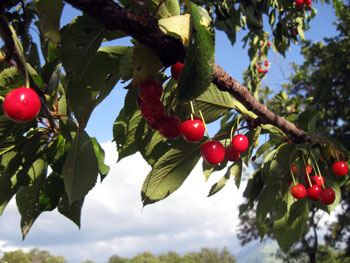 We chop and stir together in the large kitchen. Before settling down to dinner on the terrace I slip on a cardigan. Up here, fifteen hundred feet above the sultry plains below, the evening air is cool.
We chop and stir together in the large kitchen. Before settling down to dinner on the terrace I slip on a cardigan. Up here, fifteen hundred feet above the sultry plains below, the evening air is cool.
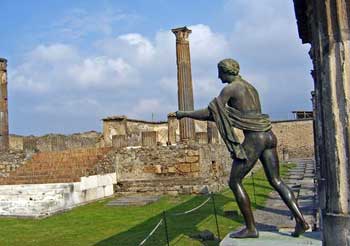
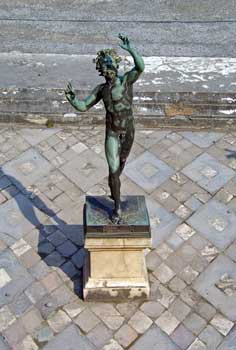 Entering ancient Porta Marina’s pedestrians-only passage, our guide introduces Pompeii. “Just like now, thousands of visitors traveled here,” Massimillio informs us. “And many different languages were spoken.”
Entering ancient Porta Marina’s pedestrians-only passage, our guide introduces Pompeii. “Just like now, thousands of visitors traveled here,” Massimillio informs us. “And many different languages were spoken.”
 Wealthy nobles lived along via de la Fortuna where elegant homes covered with bright-white ground-marble stucco stood next door to smaller houses. At House of the Faun, an undamaged mosaic displaying the original sign HAVE meaning ‘hail-to-you,’ welcomes us into the entrance hall and open courtyards. Then covering an entire block, its forty stylish rooms included magnificent dining rooms, one for each season. Carved columns had lined two immense gardens filled with marble and bronze statuary and beautiful fountains.
Wealthy nobles lived along via de la Fortuna where elegant homes covered with bright-white ground-marble stucco stood next door to smaller houses. At House of the Faun, an undamaged mosaic displaying the original sign HAVE meaning ‘hail-to-you,’ welcomes us into the entrance hall and open courtyards. Then covering an entire block, its forty stylish rooms included magnificent dining rooms, one for each season. Carved columns had lined two immense gardens filled with marble and bronze statuary and beautiful fountains. Nearby, the House of the Vetti belonged to bachelor brothers, prosperous wine-merchants. This patrician villa retains original mosaics in green jade, white Carrera marble and indigo-blue onyx; vibrantly colored frescoes decorate well-preserved entertainment rooms. At a smaller house next door, we linger over frescoes in rich earthen tones depicting delicate flowers and winged cherubs, among my favorites for their simple whimsy.
Nearby, the House of the Vetti belonged to bachelor brothers, prosperous wine-merchants. This patrician villa retains original mosaics in green jade, white Carrera marble and indigo-blue onyx; vibrantly colored frescoes decorate well-preserved entertainment rooms. At a smaller house next door, we linger over frescoes in rich earthen tones depicting delicate flowers and winged cherubs, among my favorites for their simple whimsy.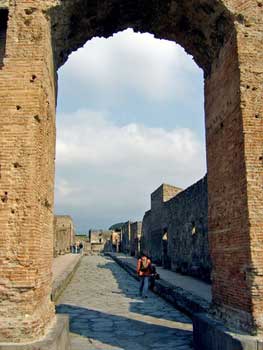 Raised sidewalks wind along the street to one of the 34 bakeries needed to feed Pompeii’s population of over 20,000. “Those squat towers made of volcanic stones milled flour on-site,” reports our guide. Amazed that the well-built ovens so closely resemble today’s brick pizza ovens, we imagine tantalizing aromas floating on the air. During excavations, centuries-old loaves of blackened breads were found inside many ovens.
Raised sidewalks wind along the street to one of the 34 bakeries needed to feed Pompeii’s population of over 20,000. “Those squat towers made of volcanic stones milled flour on-site,” reports our guide. Amazed that the well-built ovens so closely resemble today’s brick pizza ovens, we imagine tantalizing aromas floating on the air. During excavations, centuries-old loaves of blackened breads were found inside many ovens.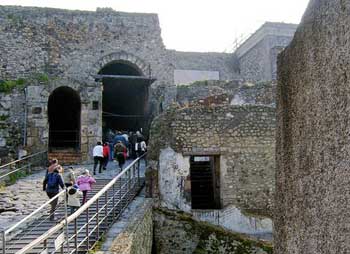 Inside, surprisingly small cells held stone beds once covered by mattresses. Using a separate entrance, wealthier clients had used the more private second-story rooms bedecked with rich frescoes leaving little to the imagination.
Inside, surprisingly small cells held stone beds once covered by mattresses. Using a separate entrance, wealthier clients had used the more private second-story rooms bedecked with rich frescoes leaving little to the imagination.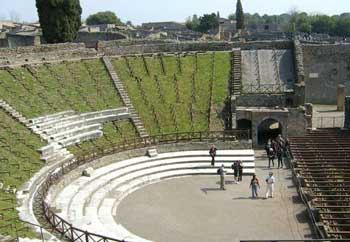 Onward past a former Temple of popular Egyptian goddess Isis, we pause among columns remaining in a second public Forum. This is where theatergoers had mingled in bars and cafes before open-air performances at their Grande Theater. First built in the 2nd-century BC, this theater seated over 5000 citizens in three price ranges. Its smaller semi-circular neighbor, the Odeon staged more intimate mime, plays and musical events.
Onward past a former Temple of popular Egyptian goddess Isis, we pause among columns remaining in a second public Forum. This is where theatergoers had mingled in bars and cafes before open-air performances at their Grande Theater. First built in the 2nd-century BC, this theater seated over 5000 citizens in three price ranges. Its smaller semi-circular neighbor, the Odeon staged more intimate mime, plays and musical events.